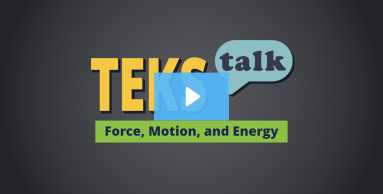- Science
- Grade 8
- Force, motion, and energy
Back to TEKS search
Science.8.8.A
The student is expected to compare the characteristics of amplitude, frequency, and wavelength in transverse waves, including the electromagnetic spectrum; and

Knowledge and Skills Statement
Force, motion, and energy. The student knows how energy is transferred through waves.
Supporting Information
Research
Bobrowsky, Matthew. “SCIENCE 101: Q: What Are Waves, and What Are Some Things They Can Do? Science and Children 58, no. 1 (2020): 62-65. https://doi.org/10.1080/00368148.2020.12315794
Summary: This article supports teacher understanding by explaining the motion of waves and sharing a model of the various components of a wave. Details on a variety of waves, how they propagate, and whether a medium is required to carry the wave are provided.
